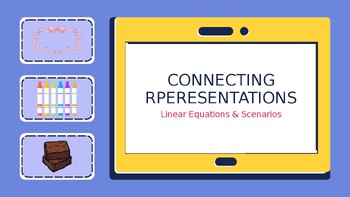*NO PREP* Connecting Representations: Linear Equations & Scenarios Slideshow
KDS Education
1 Follower
Grade Levels
7th - 9th, Homeschool
Subjects
Resource Type
Standards
CCSS7.EE.A.2
CCSS7.EE.B.3
CCSS7.EE.B.4
CCSS7.EE.B.4a
Formats Included
- PPTX
Pages
8 pages
KDS Education
1 Follower
Also included in
- Connecting representations is a math routine that you can use with your students to foster their structural thinking. This routine enables students to pay close attention to details in different representations. This routine works great to support the development of students observational skills andPrice $5.00Original Price $6.00Save $1.00
- The connecting representations math routine is guaranteed to support your learners in making connections between multiple representations in math.This bundle includes all the necessary materials you will need for the lesson - including slideshow, worksheet, and lesson plan. This connecting representPrice $7.00Original Price $9.00Save $2.00
Description
The connecting representations math routine is guaranteed to support your learners in making connections between multiple representations in math.
This slideshow is a companion to the connecting representations worksheet on the same topic. This connecting representations routine allows students to make the connection between tape diagrams and equations. This lesson explicitly supports students ability to model scenarios by creating/matching algebraic equations written in y=mx+b form. This lesson can be used to support students in developing their math literacy skills.
Implementation Recommendations
- If this is the first time using the connecting representations routine, plan for this lesson to take up to 1 hour.
- Students should be seated in pairs. Partnership can be pre-assigned (if necessary). Consider pairing kids with varied strengths. Pair English language learners with students they feel comfortable communicating with; English language learners may feel more comfortable being points over speakers.
- As the launch for this activity, students should be directed to annotate the scenario. Provide an annotation guide for the exceptional learners. If you do not already employ an annotation guide, consider using CUBES.
- Make use of a visible timer during silent observation and partner sharing to keep students on task.
- After a pair shares a connection at the board, call on volunteers to recall what the pair shared to reinforce learning.
- Provide a designated pointing tool or ruler to pointers sharing at the board.
- Circulate while students are creating representations to assess and extend their learning.
- If time permits Use a document camera to share the representations that students create.
- For full implementation recommendations, download the bundle that includes the lesson plan.
Total Pages
8 pages
Answer Key
N/A
Teaching Duration
N/A
Report this resource to TPT
Reported resources will be reviewed by our team. Report this resource to let us know if this resource violates TPT’s content guidelines.
Standards
to see state-specific standards (only available in the US).
CCSS7.EE.A.2
Understand that rewriting an expression in different forms in a problem context can shed light on the problem and how the quantities in it are related. For example, 𝘢 + 0.05𝘢 = 1.05𝘢 means that “increase by 5%” is the same as “multiply by 1.05.”
CCSS7.EE.B.3
Solve multi-step real-life and mathematical problems posed with positive and negative rational numbers in any form (whole numbers, fractions, and decimals), using tools strategically. Apply properties of operations to calculate with numbers in any form; convert between forms as appropriate; and assess the reasonableness of answers using mental computation and estimation strategies. For example: If a woman making $25 an hour gets a 10% raise, she will make an additional 1/10 of her salary an hour, or $2.50, for a new salary of $27.50. If you want to place a towel bar 9 3/4 inches long in the center of a door that is 27 1/2 inches wide, you will need to place the bar about 9 inches from each edge; this estimate can be used as a check on the exact computation.
CCSS7.EE.B.4
Use variables to represent quantities in a real-world or mathematical problem, and construct simple equations and inequalities to solve problems by reasoning about the quantities.
CCSS7.EE.B.4a
Solve word problems leading to equations of the form 𝘱𝘹 + 𝘲 = 𝘳 and 𝘱(𝘹 + 𝘲) = 𝘳, where 𝘱, 𝘲, and 𝘳 are specific rational numbers. Solve equations of these forms fluently. Compare an algebraic solution to an arithmetic solution, identifying the sequence of the operations used in each approach. For example, the perimeter of a rectangle is 54 cm. Its length is 6 cm. What is its width?







